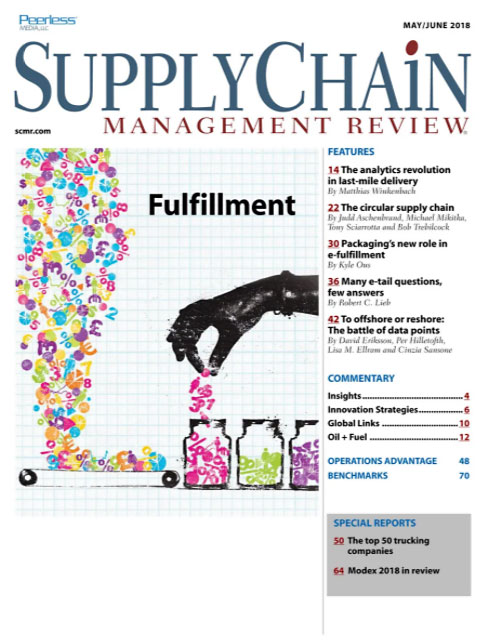Sorry, but your login has failed. Please recheck your login information and resubmit. If your subscription has expired, renew here.
May-June 2018
Last month, I was in Atlanta at the Modex trade show. In one sense, it is a tribute to the automation technologies managing today’s distribution networks. And, I’m not only talking about automated materials handling systems, but also the software and NextGen technologies such as robotics, wearable technologies, including smart glasses and augmented reality solutions and sensors enabling the Internet of Things. In another sense, all of these solutions are coming together to drive fulfillment. With the increase in e-commerce, getting the right product to the right customer at the right time has never been more important. Browse this issue archive.Need Help? Contact customer service 847-559-7581 More options
Given the number of deliveries each of us receives from Amazon, it’s hard to remember that between 2000 and 2002, the first wave of online retailing crashed as the dot.com bubble burst. Many of the failed online retailers suffered from a lack of basic logistics knowledge that contributed to their demise.
What was taking place in the online retail marketplace at that time? For starters, early online retailers were typically funded by readily available investment capital and supported by financial markets that rewarded rapid growth over sound business plans and profitability.
As online sales exploded, many misguided investments were made in transportation and warehousing assets. Price competition between online retailers was brutal, and free shipping and returns crept into the marketplace as online sellers looked for ways to differentiate themselves from their competitors. As this was happening, traditional brick-and mortar retailers were developing their own strategies to cope with the new competitive environment. The fulfillment space became increasingly crowded.

This complete article is available to subscribers only.
Log in now for full access or start your PLUS+ subscription for instant access.
SC
MR
Sorry, but your login has failed. Please recheck your login information and resubmit. If your subscription has expired, renew here.
May-June 2018
Last month, I was in Atlanta at the Modex trade show. In one sense, it is a tribute to the automation technologies managing today’s distribution networks. And, I’m not only talking about automated materials… Browse this issue archive. Access your online digital edition. Download a PDF file of the May-June 2018 issue.Given the number of deliveries each of us receives from Amazon, it's hard to remember that between 2000 and 2002, the first wave of online retailing crashed as the dot.com bubble burst. Many of the failed online retailers suffered from a lack of basic logistics knowledge that contributed to their demise.
What was taking place in the online retail marketplace at that time? For starters, early online retailers were typically funded by readily available investment capital and supported by financial markets that rewarded rapid growth over sound business plans and profitability.
As online sales exploded, many misguided investments were made in transportation and warehousing assets. Price competition between online retailers was brutal, and free shipping and returns crept into the marketplace as online sellers looked for ways to differentiate themselves from their competitors. As this was happening, traditional brick-and mortar retailers were developing their own strategies to cope with the new competitive environment. The fulfillment space became increasingly crowded.
SC
MR


Latest Supply Chain News
- Manufacturing again contracts in October, reports ISM
- 5 common communication issues
- Three frameworks for creative problem-solving in supply chain
- Mitigating geopolitical uncertainty: 4 essential tactics for industrial CSCOs
- Supply chain strategy for medical devices: A Q&A with industry expert Sanjay Gupta
- More News
Latest Podcast

 Explore
Explore
Software & Technology News
- How technological innovation is paving the way for a carbon-free future in logistics and supply chains
- Körber Supply Chain Software’s Craig Moore says MercuryGate acquisition is about the customer
- Robotic use grows by 10%
- Harnessing Edge Computing and AI Vision Systems for Real-Time Logistics Insights
- The art of winning at supply chain technology: Lessons from managing tech for the largest private trucking fleet in the U.S.
- The 3 types of cyberattacks affecting global supply chains
- More Software & Technology
Latest Software & Technology Resources

Subscribe

Supply Chain Management Review delivers the best industry content.

Editors’ Picks





